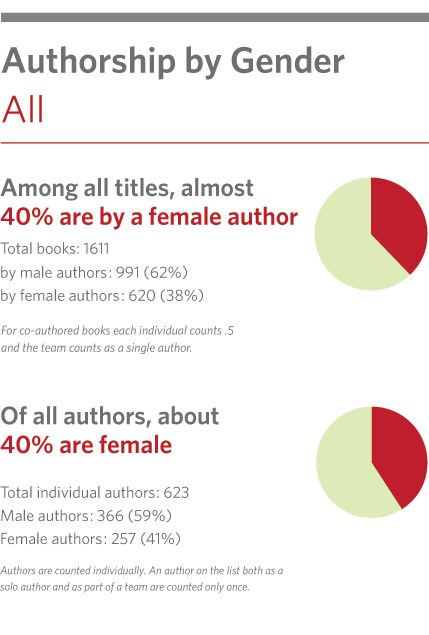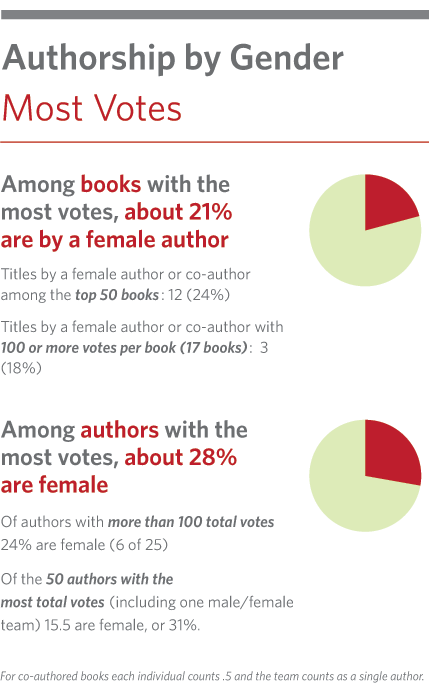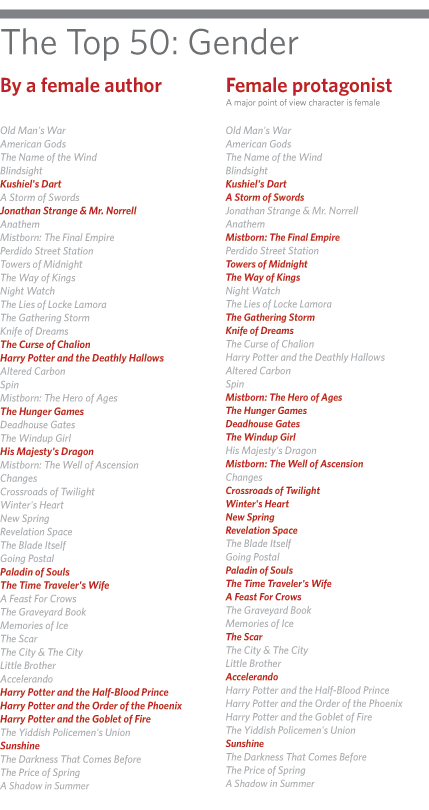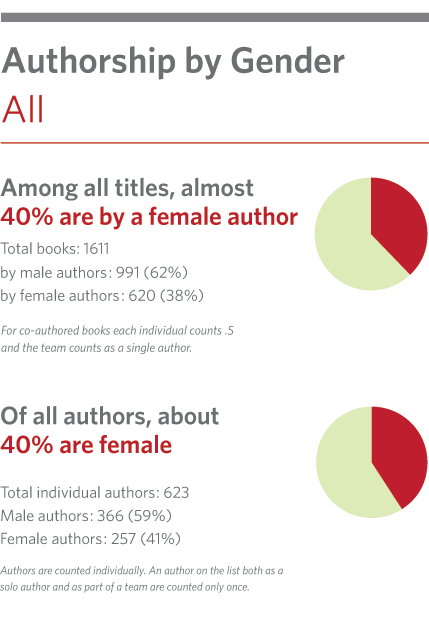One of the first things we wanted to know—once we got the Best of the Decade Reader’s Poll data into something resembling coherence—was how the titles split up among gender lines. Not only in an overall sense, but also in regards to the titles that garnered the most votes.
The conversation on gender issues in science fiction and fantasy is always ongoing. (Tor.com itself usually doesn’t go a week without bringing it up in some form.) But can a correlation be found between the visibility of that discussion and the number of SFF titles and authors published in the last decade?

Note: For the total author counts, Individual humans were counted individually. However when counting “votes per author” and deciding the authorship of books written by more than one person, each individual counts as .5, and the whole team is a single author.
This number surprised us. Fantasy and science fiction are still considered somewhat male-dominated genres, so while the male/female split in our popular vote doesn’t equal 50/50, it seems a lot closer than one might expect from anecdotal experience.
We don’t have data for pre-millennium decades, so it would be interesting to see if this number is a true shift upwards.
Let’s take a look at how gender splits amongst the most popular titles:

Download a PDF of the two above charts here.
Focusing on the top 50 titles produced a more expected split between male and female authors, with female authors making up a little less than a fourth of the most popular books.
Once we saw this data, we got curious about how many titles in the top 50 had female protagonists, and whether this data correlated in any way with the percentage of female authors. The quick answer? Not really. But the data was fun to look at all the same.

Download a PDF of the above chart here.
As you can see, nearly half of the top 50 titles feature a female protagonist. And of the 22 that we’re counting, only 5 were written by female authors.
When defining a female protagonist in a book, we focused on a couple of things. The first being whether one of the main characters was female, and whether that female protagonist character has her own agency within the story. The second was whether we get the character’s viewpoint in a sizable portion of the book. i.e. are we inside her head? Are we privy to her thoughts on a regular basis?
When we couldn’t come to a consensus about a particular character, we opted towards no. (The Harry Potter series is a tough argument in this regard. While Hermione is obviously one of the main characters, Harry himself is the clear protagonist of the series and the narrative in every book tends to center around his perspective.) We anticipate some of you may disagree with our definition and/or choices, since this category is more subjective than most of the others.
This chart is the most malleable of the entire data set, though, and we’re interested to hear our commenters make any cases to the contrary of the above chart!











A Shadow in Summer and The Price of Spring absolutely have female protagonists by the measure you’re using — central female POV characters with agency. Far more so than the Martin for instance.
As you predicted, I have a comment on your final chart!
I think this chart is somewhat misleading without a corresponding one that shows which of the top 50 have a male protagonist. It is not the case that 22/50 have a female protagonist and 28/50 have a male protagonist, which would be a nicely even split.
I haven’t read all of the books in that list, so I’d have to estimate here, but I only count four titles that don’t have a male protagonist equal to or more prominent than a female one: Kushiel’s Dart, The Hunger Games, Paladin of Souls, and Sunshine. (Please do correct me if I’ve missed some — I suspect The Windup Girl or The Time-Traveler’s Wife may qualify, but from reading descriptions of the books I’m not sure.)
That means that the real comparison is between these two figures: 22/50 of the most popular books had a female protagonist, while 46/50 had a male protagonist. Yikes.
I second bluejo’s comment re ‘A Shadow in Summer’–the character of Amat Kyaan is not only one of the central pov characters, but the most interesting in the book, imo.
The Windup Girl herself and the lieutenant of the White Shirts in Bacigalupi’s TWG qualify I think, ellenw; The Time-Traveller’s Wife probably does as well but I was too bored to finish it.
Interesting how few women write central female povs–maybe they suspect the (reality?) that too many guys are still too attached to that one chromsome difference in our human genetic makeup to give ’em a go. Or am I being too hard on my own gender here?
I agree that A SHADOW IN SUMMER counts.
ASoIaF counts more though. Half of the POV characters in A FEAST FOR CROWS are female.
I would be interesting to know the gender of the voters themselves and how they voted.
For my personal results for the books I voted for that made it to the top 50:
25% (1 of 4) were authored by a female
75% (3 of 4) have a female protagonist
Interestingly, the one that is considered not to have a female protagonist is the one authored by a female: J.K. Rowling. So you might say 100% if you disagree that Hermione doesn’t count.
@ellenw #2:
I don’t know that I would consider any male character even close to the prominence of Vin in the Mistborn series. Kelsier or Elend or Sazed would probably be the closest I suppose, but Vin is the main protagonist by a long shot.
While women are much more of readers of scifi than it used to be, but primarly I suspect readers are men. However, some of the most popular books still have female protagonists. It’s the genre and the story that matters, not the sex of the main character. There are obviously good examples above, but let me throw out one more…Honor Harrington. I would guess a high percentage of the readers of those books are men because it’s military scifi. Just like I would suspect that a high percentage of urban romance readers are women.
Interesting. I know that I have a definite preference for female authors and for female leads / strong characters and my bookshelves reflect this. However I’m lousy at voting.
Just as an aside, how would we characterize the protagonist in Charles Stross’ Glasshouse ?
Gender identity is a focus of the book, with the originally male character waking up in a female body.
I’m late seeing this post, but for those who might drop by to look at it later, book blogger James Nicoll has been doing just this sort of survey of publishers. Here’s the link to Tor’s results:
http://james-nicoll.livejournal.com/2903267.html